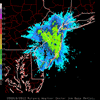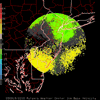Last night the winds never got cranking out of the northeast. Instead they remained light and variable, but light and variable combined with a clear night sky was enough to get the birds moving. Unfortunately when you have a clear, warm day (like yesterday) followed by a clear, cool night where the air temp cools much faster than the earth, the temperature inversion after sunset creates false signals in the radar (called anomalous propagation). These signals, when viewed on the velocity plot can be differentiated from bird migration by having no velocity associated with it. This explains why the base reflectivity plot shows so much more information than does the velocity plot. Even so, a good portion of what is seen on the base reflectivity from last night correlates bird migration, as is confirmed in the velocity (+20kts).
Now, as for insight as to where the birds may be? Without any weather to concentrate them, I’ll use my tried and true ‘bail out’ statement (sorry Susan 🙂 ):
Go to your favorite fall hotspot and give it a shot!


2 responses to “More migration, less insight”
Hah! There are secrets to finding the concentrations of migrating birds, they just aren’t revealed to those below the sixth circle. I’m not there yet, still in some kind of grid (the matrix?)
Failing that, a bright orange ball could perhaps appear on your radar, and settle, around 4 am, say, at Merrill Creek, or perhaps the Watchung Reservation.
At least, I can vaguely assess the velocity now.
As for Ground Proofing: on the morning of the 18 there were a zillion birds ready to migrate from Walkill. Did they?
see the green Susan? that’s 1 zillion birds, exactly. 😉
Where is Walkill? What’s nice about this radar feed from Rutgers is that all the county boundaries are outlined…you might be able to get a corse estimate (remember, the resolution is about 1km)